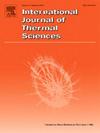Multi-objective design optimization and fluid-thermal coupling analysis on the active flow control induced by a novel aerospike-channel injection concept
IF 4.9
2区 工程技术
Q1 ENGINEERING, MECHANICAL
International Journal of Thermal Sciences
Pub Date : 2025-06-26
DOI:10.1016/j.ijthermalsci.2025.110101
引用次数: 0
Abstract
Excessive aeroheating and high wave drag problems have always been the utmost important work related to vehicles in supersonic/hypersonic flight. Mounting a spike is a potential candidate to modify the flowfield in front of the fore-bodies for drag reduction and thermal protection. In this paper, a novel aerospike-channel injection device without additional working fluid is implemented. Based on this concept, investigations on the proposed configuration are carried out by using numerical simulation combined with multi-objective design optimization methods. The non-dominated sorting genetic algorithm II multi-objective algorithm coupled with the Kriging surrogates is utilized for the multi-objective design optimization, and the fluid-thermal interaction simulations are constructed based on loosely coupled analysis. The flow structure and fluid-thermal coupling characteristics depending on the freestream conditions (Mach number: 5 to 7 at 27 km, altitude: 20–27 km at q∞ = 47 kPa) are examined and discussed in detail. Compared with the distinguished configuration obtained from numerical simulation, the optimized designs provide further reductions of 6.73 % and 6.51 % in drag and aeroheating, respectively. Moreover, it is found that the drag response of the spiked model mainly depends on the spike length L/D, whereas the aeroheating is mainly controlled by the injection location. In addition, this paper emphasizes that it is necessary to conduct a coupled fluid-thermal analysis to accurately capture the dynamic thermal response of the vehicles.
新型气刺通道喷射主动流动控制的多目标设计优化及流热耦合分析
在超声速/高超声速飞行中,过度气动加热和高波阻问题一直是与飞行器相关的最重要的工作。安装尖钉是一种潜在的选择,可以改变前体前面的流场,以减少阻力和热保护。本文设计了一种不需要额外工作流体的新型气刺通道喷射装置。在此基础上,采用数值模拟与多目标设计优化相结合的方法对所提出的构型进行了研究。采用非支配排序遗传算法II多目标算法,结合Kriging代理进行多目标设计优化,并基于松耦合分析构建了流-热耦合仿真。对自由流条件下(27 km马赫数5 ~ 7,q∞= 47 kPa高度20 ~ 27 km)的流动结构和流热耦合特性进行了详细的研究和讨论。与数值模拟结果相比,优化后的设计进一步降低了6.73%的阻力和6.51%的气动加热。此外,研究发现尖峰模型的阻力响应主要取决于尖峰长度L/D,而气动加热主要由喷射位置控制。此外,本文还强调,为了准确捕捉车辆的动态热响应,有必要进行流-热耦合分析。
本文章由计算机程序翻译,如有差异,请以英文原文为准。
求助全文
约1分钟内获得全文
求助全文
来源期刊

International Journal of Thermal Sciences
工程技术-工程:机械
CiteScore
8.10
自引率
11.10%
发文量
531
审稿时长
55 days
期刊介绍:
The International Journal of Thermal Sciences is a journal devoted to the publication of fundamental studies on the physics of transfer processes in general, with an emphasis on thermal aspects and also applied research on various processes, energy systems and the environment. Articles are published in English and French, and are subject to peer review.
The fundamental subjects considered within the scope of the journal are:
* Heat and relevant mass transfer at all scales (nano, micro and macro) and in all types of material (heterogeneous, composites, biological,...) and fluid flow
* Forced, natural or mixed convection in reactive or non-reactive media
* Single or multi–phase fluid flow with or without phase change
* Near–and far–field radiative heat transfer
* Combined modes of heat transfer in complex systems (for example, plasmas, biological, geological,...)
* Multiscale modelling
The applied research topics include:
* Heat exchangers, heat pipes, cooling processes
* Transport phenomena taking place in industrial processes (chemical, food and agricultural, metallurgical, space and aeronautical, automobile industries)
* Nano–and micro–technology for energy, space, biosystems and devices
* Heat transport analysis in advanced systems
* Impact of energy–related processes on environment, and emerging energy systems
The study of thermophysical properties of materials and fluids, thermal measurement techniques, inverse methods, and the developments of experimental methods are within the scope of the International Journal of Thermal Sciences which also covers the modelling, and numerical methods applied to thermal transfer.
 求助内容:
求助内容: 应助结果提醒方式:
应助结果提醒方式:


